Wildlife Ecology
Students record observations of evidence for the presence of wildlife in their study area. They compare the diversity found in different areas and investigate the biotic and abiotic factors influencing the distribution of wildlife.
Grade Level: 5th - 8th
Time Needed: 2.5 hours
Downloadable PowerPoint Presentation, PowerPoint Script,
and Teaching Unit Booklet with Lesson Plans
To download, open the link and then use the "File/Save" pulldown menu from the toolbar on your browser.
Animal Signs - PowerPoint file
(Note: The "Animal Signs" PPt is a large file, 16.2 MB, and takes a while to load)
Animal Signs - Text/Script (PDF file)
Wildlife Ecology Module/Unit (PDF file, 3 MB)
U.S. Fish and Wildlife Service – Ecosystem Conservation - http://ecosystems.fws.gov/
This Web site gives an overview of how the FWS takes an ecosystem approach to managing wildlife.
Ecological Society of America – Report on the Scientific Basis of Ecosystem Management -
This lengthy report from a professional group for ecologists provides detailed background on using ecology as a tool to make decisions about managing resources.
Green Teacher Magazine – Planet Earth Pages: The Outdoor Classroom. http://www.greenteacher.com/articles/50planet.html
This website contains several ecology-related activities for various age groups. Back issues of Green Teacher can be obtained through www.greenteacher.com, e-mail: [email protected], Phone: (416) 960-1244, Fax: (416) 925-3474, or by writing to Green Teacher at P.O. Box 1431, Lewiston, NY 14092
U.S. EPA – Mid-Atlantic Region Integrated Assessment – http://www.epa.gov/maia/index.html
The Mid-Atlantic Integrated Assessment is a research, monitoring, and assessment initiative. Its goal is to develop high-quality scientific information on the condition of the natural resources of the Mid-Atlantic region of the U.S., including the watersheds of the Delaware Bay.
The Pennsylvania Cooperative Fish and Wildlife Research Unit – http://pacfwru.cas.psu.edu/
This organization is a cooperative of various state and federal wildlife organizations, including the Pa. Game Commission, Fish and Boat Commission, and Penn State University. Part of their mission is to conduct research on wildlife species and publicize the findings.
Web sites for the students:
Environmental Protection Agency Student Center - http://www.epa.gov/students/
This website provides information on a variety of environmental topics.
LESSON 2 Links - FIELD STUDY TECHNIQUES
Web sites for the teacher:
American Museum of Natural History- Online Field Journals. (Field journals include: Birds, Insects, Butterflies, Leaves, Animal Tracks, Reptiles, Flowers and Spiders.) http://www.amnh.org/nationalcenter/online_field_journal/
EduScapes - The Topic: Animal Tracks. Lamb, A and Johnson, L.
http://eduscapes.com/42explore/animaltracks.htm
Websites on tracking, projects, and other resources.
Crinkleroot’s Animal Tracking. York, J.
http://www.scs.k12.tn.us/STT2000_wq/2-5/yorkl/default.htm
This is a WebQuest written for Jim Arnosky’s story Crinkleroot’s Animal Tracking.
Web sites for the students:
Virtual Cub Scout Leader’s Handbook- Tracking and Stalking North American Wildlife. http://www.geocities.com/Yosemite/9152/wildlife.html
This is a cyber-guide for scouts, and includes tracking basics, safety, and information on various wildlife species.
LESSON 3 Links - OUTDOOR FIELD STUDY
Web sites for the teacher:
Neartica- Eastern Deciduous Forest.
http://www.nearctica.com/biomes/edf/index.htm
This is a great resource for Eastern deciduous forests, including information about plants, animals, soils, and much more. *Note: this site contains several banner advertisements.
LESSON 5 Links - WRITING AN ENVIRONMENTAL IMPACT STATEMENT
Web sites for the teacher:
Utah State Office of Education- Earth’s Biological Systems. http://www.wested.org/werc/earthsystems/biology/lpbiology.html.
Click on “Evaluate Ecosystems” for a lesson on environmental inventory.
EPA Office of Federal Activities-
Environmental impact statements are listed on this site when they are published, and other resources are available such on how to file an EIS.
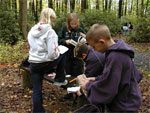 |
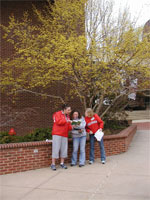 PA Biodiversity Workshop for Muhlenberg Student Teachers, Sponsored by PA Game Commission |
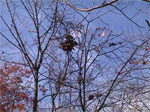 Squirrel Nest in Top of Tree |
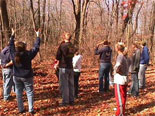 Project WILD Workshop for Muhlenberg Student Teachers |
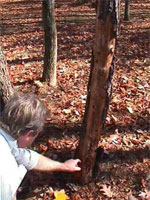 Bill Sweeney from the PA DCNR, Project WILD Facilitator at Workshop for Muhlenberg Student Teachers |
 Chewed Hickory Nuts |
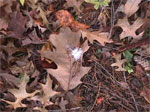 Bird Droppings on Oak Leaf |
